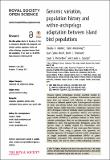Por favor, use este identificador para citar o enlazar a este item:
http://hdl.handle.net/10261/240029COMPARTIR / EXPORTAR:
 SHARE SHARE
 CORE
BASE CORE
BASE
|
|
| Visualizar otros formatos: MARC | Dublin Core | RDF | ORE | MODS | METS | DIDL | DATACITE | |

| Título: | Genomic variation, population history and within-archipelago adaptation between island bird populations |
Autor: | Martin, Claudia A.; Armstrong, Claire; Illera, Juan Carlos CSIC ORCID; Emerson, Brent C. CSIC ORCID ; Richardson, David S.; Spurgin, Lewis G. | Palabras clave: | Adaptation Population genetics Birds Colonization history Genome scan Spatial scales |
Fecha de publicación: | 3-feb-2021 | Editor: | Royal Society (Great Britain) Royal Society of Chemistry (UK) |
Citación: | Royal Society Open Science 8(2), 201146: 1-16 (2021) | Resumen: | Oceanic island archipelagos provide excellent models to understand evolutionary processes. Colonization events and gene flow can interact with selection to shape genetic variation at different spatial scales. Landscape-scale variation in biotic and abiotic factors may drive fine-scale selection within islands, while long-term evolutionary processes may drive divergence between distantly related populations. Here, we examine patterns of population history and selection between recently diverged populations of the Berthelot's pipit (Anthus berthelotii), a passerine endemic to three North Atlantic archipelagos. First, we use demographic trees and f3 statistics to show that genome-wide divergence across the species range is largely shaped by colonization and bottlenecks, with evidence of very weak gene flow between populations. Then, using a genome scan approach, we identify signatures of divergent selection within archipelagos at single nucleotide polymorphisms (SNPs) in genes potentially associated with craniofacial development and DNA repair. We did not detect within-archipelago selection at the same SNPs as were detected previously at broader spatial scales between archipelagos, but did identify signatures of selection at loci associated with similar biological functions. These findings suggest that similar ecological factors may repeatedly drive selection between recently separated populations, as well as at broad spatial scales across varied landscapes. | Versión del editor: | https://doi.org/10.1098/rsos.201146 | URI: | http://hdl.handle.net/10261/240029 | DOI: | 10.1098/rsos.201146 | E-ISSN: | 2054-5703 |
| Aparece en las colecciones: | (IPNA) Artículos |
Ficheros en este ítem:
| Fichero | Descripción | Tamaño | Formato | |
|---|---|---|---|---|
| Genomic-Emerson-2021-RoyalSocietyOpenScience.pdf | Artículo principal | 2,18 MB | Adobe PDF |  Visualizar/Abrir |
CORE Recommender
PubMed Central
Citations
3
checked on 05-abr-2024
SCOPUSTM
Citations
8
checked on 19-abr-2024
WEB OF SCIENCETM
Citations
7
checked on 23-feb-2024
Page view(s)
64
checked on 19-abr-2024
Download(s)
84
checked on 19-abr-2024

